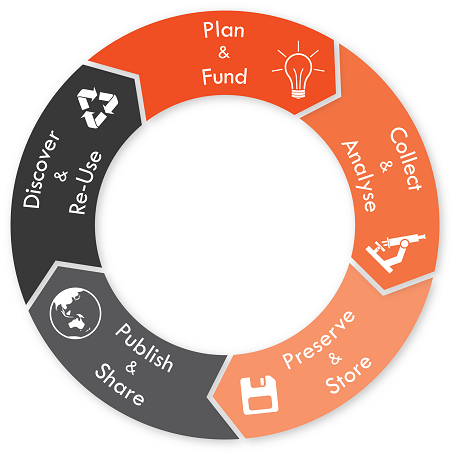Research data lifecycle
The research data lifecycle is a crucial aspect of conducting and managing research. It outlines the various stages involved in creating, analyzing, and preserving data collected for research purposes.

Effective management of research data throughout its lifecycle is important for ensuring the validity of results and facilitating the dissemination and reuse of data. This guide provides a concise overview of the steps involved in the research data lifecycle, highlighting key considerations and best practices for each stage.
Planning
Planning is the first phase of the research data lifecycle, where researchers define their goals and objectives, and determine the data they need to achieve them. Best practices for the planning phase include developing a clear research question, identifying relevant data sources, and determining what type of data is required. This phase is also the time to consider data management and data sharing strategies, so that data is collected in a manner that is consistent with the researcher’s goals and with best practices for data management.
Collection
Data collection is the phase of the research data lifecycle where data is acquired from various sources. Best practices for data collection include using validated and reliable data sources, documenting the methods used to collect data, and ensuring that the data is collected in a manner that is consistent with ethical and legal requirements. This phase is also the time to consider data security, to ensure that data is protected from unauthorised access and that sensitive information is protected.
Processing
Data processing involves cleaning, transforming, and integrating data so that it is ready for analysis. Best practices for data processing include using automated processes where possible, documenting the methods used to process data, and ensuring that data is transformed in a manner that is consistent with the research goals. This phase is also the time to consider data quality and to ensure that data is free from errors and inconsistencies.
Analysis
Data analysis is the phase of the research data lifecycle where data is analyzed to draw conclusions and answer research questions. Best practices for data analysis include using appropriate statistical methods, validating results with independent data sources, and documenting the methods used to analyze data. This phase is also the time to consider data visualisation and to create visual representations of the data that help to communicate the results to others.
Preservation
Data preservation involves storing data for long-term access and use. Best practices for data preservation include using secure and reliable storage systems, using digital preservation techniques where appropriate, and ensuring that data is stored in a manner that is consistent with the researcher’s goals and with best practices for data management. This phase is also the time to consider data security and to ensure that data is protected from unauthorised access and that sensitive information is protected.
Reuse
Data reuse involves allowing others to use and build upon data for research purposes. Best practices for data reuse include making data available through appropriate data sharing platforms, documenting the methods used to share data, and ensuring that data is shared in a manner that is consistent with ethical and legal requirements. This phase is also the time to consider data licensing and to ensure that data is used in a manner that is consistent with the researcher’s goals and with best practices for data management.
General Recommendations
Document data collection methods and processing steps
Use appropriate file formats for long-term preservation and accessibility
Consider ethical considerations, such as data privacy and security, during all stages of the lifecycle
Plan for data sharing and preservation early in the project